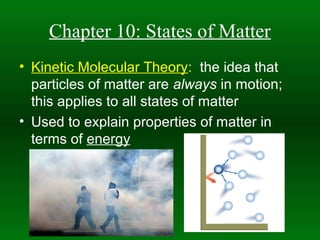
Chapter 10 – states of matter
- 1. Chapter 10: States of Matter • Kinetic Molecular Theory: the idea that particles of matter are always in motion; this applies to all states of matter • Used to explain properties of matter in terms of energy
- 2. Ideal Gas = hypothetical gas that perfectly fits all 5 assumptions of the Kinetic Molecular Theory: 1) Gases consist of a large # of particles that occupy a larger space with respect to their relative sizes thus gases can be easily compressed 2) Collisions b/t particles and walls are perfectly elastic ( = no loss of KE) 3) Gas particles are in rapid, random, constant motion 4) There are no forces of attraction b/t gas particles 5) Temperature of a gas depends on the average KE of the particles; directly proportional A gas that is always a gas - Doesn’t exist!
- 3. Characteristics of Gases • Expansion: no definite shape or volume; fill any container, regardless of shape • Fluidity: particles slide easily over one another; act like liquids, thus they are both fluids • Low Density and Compressibility: volume can be decreased greatly • Diffusion: since gases are always randomly moving, freely mix together with other gases • Effusion: process by which gases move out of a small opening; molecules with low mass effuse more quickly than those with larger masses KE= ½ mv2
- 4. Liquids • Least common state of matter in universe; not so on Earth • Operate at slim range of temps/pressures • Volume, shape, density? • Particles in constant motion, and closer than those of a gas (d/t intermolecular forces
- 5. Other Characteristics of liquids: • Have a very high density when compared to gases; depends on temperature lower temp…except for water • Not easily compressed • Easily diffuse in other liquids it can dissolve in d/t… much slower than it is in gases – why?
- 6. Surface Tension • All liquids exhibit surface tension = a force that tends to pull adjacent particles at a liquids surface together, decreasing its surface area to the smallest possible size; meniscus • Results from… water shows high surface tension • Capillary action = attraction of a liquid to a solid; rises in a small tube against gravity
- 7. Surface Tension Look at the picture below. The milk forms small droplets that resemble a crown. But why does this happen? Because of the surface tension of water, which keeps the droplets spherical.
- 8. Some terms: melting/freezing point boiling/condensation point 0ºC 100ºC solid liquid gas MELTING BOILING FREEZING CONDENSATION (ice) (water) (steam) SUBLIMATION
- 9. More info on Liquids • Vaporization – liquid to gas • Evaporation – escape from a non-boiling liquid at its surface • Boiling – vaporization through the entire liquid • Freezing – physical change from liquid to solid through the loss of HEAT. Evaporation- a beautiful process.
- 10. Solids • Particles in a solid are tightly- packed together due to attractive forces. Highly-ordered. • Atomic/molecular motion is restricted, but it occurs. Sodium Chloride crystals • 2 types: 1) Crystalline: consists of crystals (orderly, geometric, repeating pattern) 2) Amorphous: particles are Amorphous solid randomly arranged
- 11. Properties of solids • Definite shape and volume • Definite melting point (d/t addition of heat) • High density and incompressible • Low rates of diffusion
- 12. Crystals • Arranged in a lattice structure • Smallest unit of a crystal that shows the 3- D pattern of the lattice = UNIT CELL
- 13. Changes of State • Phase = any part of a system that has a uniform composition and properties • Condensation = process by which a gas turns into a liquid • Vapor = a gas in contact with its liquid or solid phase
- 14. Vapor Pressure • The pressure exerted by a vapor that is in equilibrium with its corresponding liquid • Develops in a closed system • Increase AKE, increase particles leaving liquid, increased pressure • Volatile liquids evaporate easily d/t weak IMF
- 15. Vapor Pressure
- 16. Notes on Boiling Point • BP = when vapor pressure equals atmospheric pressure • Increase pressure, increase BP = pressure cooker • Molar Enthalpy of Vaporization = amount of heat needed to vaporize 1 mole of a liquid at the liquid’s BP at a constant pressure; the stronger the attraction…. • Vapor pressure is directly proportional to temperature • Vacuum evaporator – how does it work?
- 17. Freezing and Melting • Definitions? • What is the difference b/t freezing water and ice? Boiling water and steam?
- 18. Do Now • Explain the importance and significance of this graph…
- 19. More Vocab • Molar Enthalpy of Fusion = the amount of heat required to melt one mole of a solid (40.79 kJ/mol for water) • Sublimation vs. deposition
- 20. Phase Diagrams graph of pressure vs. temperature that shows the conditions under which the phases of a substance would exist
- 21. Water • Most abundant liquid on Earth; essential to life; most reactions take place in it IMPORTANT!!! • Review its structure and properties…
- 22. Water